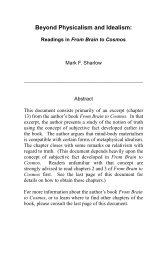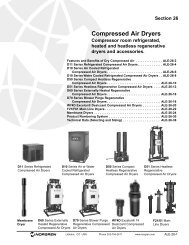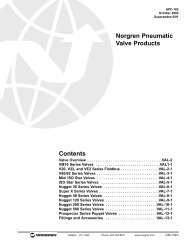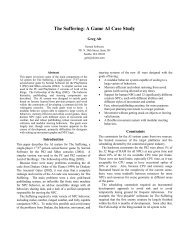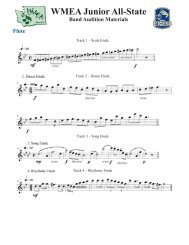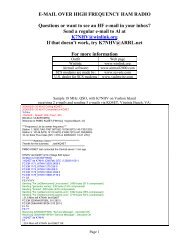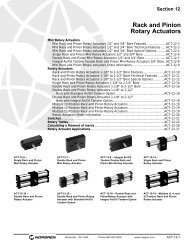Generalizing the Algebra of Physical Quantities - Eskimo North
Generalizing the Algebra of Physical Quantities - Eskimo North
Generalizing the Algebra of Physical Quantities - Eskimo North
Create successful ePaper yourself
Turn your PDF publications into a flip-book with our unique Google optimized e-Paper software.
<strong>Generalizing</strong> <strong>the</strong> <strong>Algebra</strong> <strong>of</strong> <strong>Physical</strong> <strong>Quantities</strong><br />
Mark F. Sharlow<br />
URL: http://www.eskimo.com/~msharlow<br />
ABSTRACT<br />
In this paper, I define and study an abstract algebraic structure, <strong>the</strong> dimensive algebra,<br />
which embodies <strong>the</strong> most general features <strong>of</strong> <strong>the</strong> algebra <strong>of</strong> dimensional physical<br />
quantities. I prove some elementary results about dimensive algebras and suggest some<br />
directions for future work.<br />
Copyright © 2003 Mark F. Sharlow. Updated 2009.
-1-<br />
1. INTRODUCTION. Scientists and engineers routinely use physical quantities to<br />
represent <strong>the</strong> measured properties <strong>of</strong> physical objects. Some ma<strong>the</strong>maticians have studied<br />
physical quantities from a more abstract standpoint, with <strong>the</strong> aim <strong>of</strong> better understanding<br />
<strong>the</strong> nature and use <strong>of</strong> those quantities. There are two strictly ma<strong>the</strong>matical disciplines that<br />
concern <strong>the</strong>mselves mainly with physical quantities. One is measurement <strong>the</strong>ory, which is<br />
a rigorous study <strong>of</strong> <strong>the</strong> correspondence between physical quantities and <strong>the</strong> properties <strong>the</strong>y<br />
represent (see, for example, [3]). The o<strong>the</strong>r is dimensional analysis, which concerns itself<br />
with <strong>the</strong> algebraic rules governing physical quantities and analyzes those rules to facilitate<br />
physical calculations and derivations.<br />
This paper is a study <strong>of</strong> physical quantities from yet ano<strong>the</strong>r point <strong>of</strong> view. In this<br />
paper, I investigate some abstract algebraic structures that capture <strong>the</strong> most general and<br />
characteristic features <strong>of</strong> <strong>the</strong> algebra <strong>of</strong> physical quantities. The study <strong>of</strong> physical<br />
quantities from an abstract algebraic standpoint is not a new idea. Earlier authors [1, 4, 5,<br />
6] have used <strong>the</strong> methods <strong>of</strong> abstract algebra to rigorize <strong>the</strong> foundations <strong>of</strong> dimensional<br />
analysis. My aim in this paper is slightly different: I intend to define and study a type <strong>of</strong><br />
abstract algebraic structure that embodies only <strong>the</strong> most general algebraic properties<br />
common to all systems <strong>of</strong> dimensional quantities. Once <strong>the</strong>se structures have been<br />
introduced, one can ask which additional algebraic axioms one must impose on such<br />
structures to make certain rules <strong>of</strong> dimensional analysis hold in <strong>the</strong>m. It will turn out that<br />
elementary dimensional analysis, <strong>of</strong> <strong>the</strong> kind <strong>of</strong>ten taught to beginning physics students,<br />
actually requires very little by way <strong>of</strong> additional constraints on <strong>the</strong> algebra.<br />
The structures introduced and studied here are called dimensive algebras. The main<br />
algebraic structures introduced in references [1], [4], [5] and [6] are special cases <strong>of</strong><br />
dimensive algebras. The present study owes a particular debt to <strong>the</strong> approach adopted by<br />
Whitney, especially in <strong>the</strong> earlier parts <strong>of</strong> [5].<br />
The study <strong>of</strong> dimensive algebras has four potential benefits. First, it can enhance our<br />
understanding <strong>of</strong> <strong>the</strong> algebra <strong>of</strong> physical quantities, and in particular <strong>of</strong> <strong>the</strong> relationship<br />
between physical quantity systems and o<strong>the</strong>r algebraic systems. Second, it may have
-2-<br />
pedagogical benefits, since it shows what assumptions really underlie <strong>the</strong> most commonly<br />
used rules <strong>of</strong> dimensional analysis. Third, it lets us develop <strong>the</strong> beginnings <strong>of</strong> a <strong>the</strong>ory <strong>of</strong><br />
generalized dimensional quantities -- items such as operators, vectors and matrices which<br />
have physical dimensions and units, but are not numbers. These objects occur abundantly<br />
in physical <strong>the</strong>ory, but are not fully encompassed by existing abstract algebraic treatments<br />
<strong>of</strong> dimensional quantities. Fourth, <strong>the</strong> study <strong>of</strong> dimensive algebras may lead to some<br />
interesting algebraic problems, quite apart from <strong>the</strong> original physical motivation <strong>of</strong> those<br />
structures.<br />
The chief aim <strong>of</strong> this paper is not <strong>the</strong> proving <strong>of</strong> <strong>the</strong>orems, but ra<strong>the</strong>r <strong>the</strong> introduction<br />
<strong>of</strong> potentially interesting concepts. Much <strong>of</strong> <strong>the</strong> paper is an exploration <strong>of</strong> possibilities for<br />
algebraic structures modeled on systems <strong>of</strong> physical quantities. At times I will point out<br />
<strong>the</strong> differences (sometimes striking) between <strong>the</strong>se structures and physical quantity<br />
systems. In Section 2, I provide a little more background information relevant to <strong>the</strong><br />
project <strong>of</strong> <strong>the</strong> paper. Beginning with Section 3, I introduce <strong>the</strong> definitions <strong>of</strong> dimensive<br />
algebra and <strong>of</strong> several related notions. Although proving <strong>the</strong>orems is not my principal<br />
aim, I do prove or assert some results along <strong>the</strong> way.<br />
2. DIMENSIONAL QUANTITIES IN SCIENCE. In <strong>the</strong> physical sciences, as in all<br />
disciplines that involve measurement, one <strong>of</strong>ten makes use <strong>of</strong> dimensional quantities -- that<br />
is, quantities which can be expressed as a combination <strong>of</strong> a pure numerical coefficient and<br />
a unit <strong>of</strong> measurement. Examples <strong>of</strong> such quantities are 1 meter, 20.2 miles, 3 kg, and 5<br />
days. The results <strong>of</strong> physical measurements typically are quantities <strong>of</strong> this sort.<br />
Dimensional quantities obey algebraic rules similar to, yet in some respects different<br />
from, <strong>the</strong> rules <strong>of</strong> algebra for numbers. For example, quantities with units can be<br />
multiplied and divided by each o<strong>the</strong>r; <strong>the</strong> result <strong>of</strong> such an operation is equal to <strong>the</strong><br />
product or quotient <strong>of</strong> <strong>the</strong> coefficients <strong>of</strong> <strong>the</strong> two quantities, times <strong>the</strong> product or quotient<br />
<strong>of</strong> <strong>the</strong> quantities' units. A quantity with units can be multiplied or divided by a number,<br />
and two quantities with units can be added or subtracted provided that <strong>the</strong> two quantities
-3-<br />
involved have <strong>the</strong> same units. However, two quantities with different units cannot be<br />
added to or subtracted from one ano<strong>the</strong>r; <strong>the</strong> results <strong>of</strong> such an operation are not defined.<br />
This last fact constitutes one <strong>of</strong> <strong>the</strong> main differences between <strong>the</strong> algebra <strong>of</strong> dimensional<br />
quantities and that <strong>of</strong> pure numbers.<br />
The ma<strong>the</strong>matical literature contains several studies <strong>of</strong> <strong>the</strong> algebraic properties <strong>of</strong><br />
dimensional quantities (see in particular [1, 4, 5, 6]). Many <strong>of</strong> <strong>the</strong>se studies are concerned<br />
with <strong>the</strong> foundations <strong>of</strong> dimensional analysis, a ma<strong>the</strong>matical technique used in <strong>the</strong><br />
sciences to extract information about physical relationships between quantities from<br />
information about <strong>the</strong> quantities' dimensions or units. Dimensional analysis utilizes known<br />
algebraic properties <strong>of</strong> dimensional quantities to discover or verify scientifically useful<br />
relationships among physical variables.<br />
3. DIMENSIVE ALGEBRAS. When one compares <strong>the</strong> set <strong>of</strong> dimensional quantities to<br />
sets <strong>of</strong> dimensionless numbers (real or natural), one notices a striking difference: among<br />
<strong>the</strong> dimensional quantities, not every pair <strong>of</strong> quantities can be added. This is perhaps <strong>the</strong><br />
most striking algebraic feature <strong>of</strong> dimensional quantities. The addition <strong>of</strong> such quantities<br />
is not a binary operation on <strong>the</strong> entire set <strong>of</strong> dimensional quantities. It becomes a binary<br />
operation only when restricted to any set <strong>of</strong> quantities with <strong>the</strong> same dimensions. On a set<br />
containing quantities <strong>of</strong> different dimensions, addition becomes a partial binary operation<br />
(see [3, p. 17]): something like a binary operation, except that not every pair <strong>of</strong> elements<br />
has a sum.<br />
If we want to treat all dimensional quantities toge<strong>the</strong>r as an algebraic system, we must<br />
allow for <strong>the</strong> possibility <strong>of</strong> a "binary operation" which is something less than a binary<br />
operation on <strong>the</strong> whole system, but which acts like a binary operation on certain subsets <strong>of</strong><br />
<strong>the</strong> system (<strong>the</strong> sets <strong>of</strong> quantities <strong>of</strong> <strong>the</strong> same dimensions). This generalized notion <strong>of</strong> a<br />
binary operation is captured in <strong>the</strong> following definitions:
-4-<br />
Definition 1. Let S be a set. An axiation <strong>of</strong> S is a pair 〈X, C〉, where X is a set <strong>of</strong> subsets<br />
<strong>of</strong> S, C ⊆ S, and <strong>the</strong> following conditions hold: (1) ∪X = S; (2) for any A, B∈X, A∩B<br />
= C; (3) for each A∈X, A-C ≠ ∅. The set C is called <strong>the</strong> core <strong>of</strong> <strong>the</strong> axiation.<br />
Definition 2. Let U = 〈X, C〉 be an axiation <strong>of</strong> S. A dimensive addition on S over U is a<br />
map +: ∪ A∈X A 2 → S such that for each A∈X, if x, y∈A <strong>the</strong>n +(x,y)∈A. (We can write<br />
+(x,y) as x+y.)<br />
An axiation <strong>of</strong> a set corresponds to <strong>the</strong> intuitive notion <strong>of</strong> a subdivision <strong>of</strong> a set into<br />
smaller sets <strong>of</strong> "similar" elements (in particular, elements having <strong>the</strong> same physical<br />
dimension). If we understand an axiation this way, <strong>the</strong>n a dimensive addition is a partial<br />
binary operation which allows us to combine elements <strong>of</strong> <strong>the</strong> same kind.<br />
Since <strong>the</strong> intuitive significance <strong>of</strong> <strong>the</strong> core C may not be obvious, a few remarks<br />
regarding its intended interpretation are in order. One reason for including C in Definition<br />
1 is to keep <strong>the</strong> definition <strong>of</strong> axiation consistent with earlier rigorous treatments <strong>of</strong><br />
dimensional quantities. Whitney, in particular, has developed a definition <strong>of</strong> a system <strong>of</strong><br />
dimensional quantities ("quantity structure") in which a single zero element is shared by all<br />
<strong>the</strong> dimensions represented in <strong>the</strong> structure [6, p. 235]. (One might think <strong>of</strong> this as a<br />
formalization <strong>of</strong> <strong>the</strong> informal scientific practice <strong>of</strong> jotting down expressions like "∆t = ∆x<br />
= 0" in place <strong>of</strong> more formal expressions like "∆t = 0 sec, ∆x = 0 m.") The core C in<br />
Definition 1 allows us to construct axiations in which all axes share <strong>the</strong> same zero element,<br />
by letting C be <strong>the</strong> singleton <strong>of</strong> that element. If we do not choose to treat zero quantities<br />
in this way, we may set C = ∅ and distinguish between quantities like 0 m and 0 kg.<br />
Ano<strong>the</strong>r reason for including C is that its presence in <strong>the</strong> definition helps us draw certain<br />
parallels between different algebraic systems (this remark will become clearer later in <strong>the</strong><br />
paper). However, one can set C = ∅ throughout most <strong>of</strong> <strong>the</strong> rest <strong>of</strong> <strong>the</strong> paper if one<br />
prefers to do so.<br />
The general restriction against adding quantities with different dimensions is perhaps
-5-<br />
<strong>the</strong> most conspicuous feature <strong>of</strong> <strong>the</strong> algebra <strong>of</strong> physical quantities. It is this feature which<br />
most clearly differentiates that algebra from <strong>the</strong> familiar ma<strong>the</strong>matics <strong>of</strong> numbers. Ano<strong>the</strong>r<br />
conspicuous feature <strong>of</strong> physical quantity algebra is <strong>the</strong> fact that <strong>the</strong> multiplication <strong>of</strong> two<br />
physical quantities always is posible. Multiplication is a binary operation on <strong>the</strong> set <strong>of</strong> all<br />
dimensional quantities. What is more, this multiplication induces a binary operation on <strong>the</strong><br />
set <strong>of</strong> dimensions for those quantities. For example, if one multiplies a force by a length,<br />
one always gets a quantity with dimensions <strong>of</strong> energy. (In terms <strong>of</strong> <strong>the</strong> familiar notation <strong>of</strong><br />
dimensional analysis, [force] × [length] = [energy].) We can express this characteristic <strong>of</strong><br />
dimensional multiplication in terms <strong>of</strong> axiations as follows:<br />
Definition 3. Let U = 〈X, C〉 be an axiation <strong>of</strong> S. A dimensive multiplication on S over<br />
U is a binary operation • on S such that for each A, B ∈X, if a, b∈A and x, y∈B <strong>the</strong>n a•x<br />
and b•y belong to <strong>the</strong> same element <strong>of</strong> X. Ordinarily we write a•x as ax.<br />
The addition and multiplication <strong>of</strong> dimensional physical quantities are examples <strong>of</strong><br />
dimensive addition and multiplication as defined in Definitions 2 and 3.<br />
With <strong>the</strong> definitions <strong>of</strong> dimensive addition and multiplication in hand, we can define an<br />
algebraic system which has operations <strong>of</strong> <strong>the</strong>se two sorts.<br />
Definition 4. An axial algebra U is a quadruplet 〈S, 〈X, C〉, +, •〉, where S is a set, 〈X,<br />
C〉 is an axiation on S, + is a dimensive addition on S over 〈X, C〉 (called addition in U),<br />
and • is a binary operation on S over 〈X, C〉 (called multiplication in U). The sets A∈X<br />
are called <strong>the</strong> axes <strong>of</strong> U. The core C <strong>of</strong> <strong>the</strong> axiation is called <strong>the</strong> core <strong>of</strong> U.<br />
An axial algebra is a system <strong>of</strong> elements classified into kinds such that quantities <strong>of</strong><br />
different kinds cannot be added to one ano<strong>the</strong>r and any two quantities can be multiplied<br />
toge<strong>the</strong>r. Thus, <strong>the</strong> concept <strong>of</strong> an axial algebra abstracts out <strong>the</strong> most general and<br />
conspicuous features <strong>of</strong> <strong>the</strong> algebra <strong>of</strong> physical quantities.
-6-<br />
Definition 5. A dimensive algebra is an axial algebra 〈S, 〈X, C〉, +, •〉 whose<br />
multiplication • is a dimensive multiplication on S.<br />
A dimensive algebra is an axial algebra in which <strong>the</strong> multiplication <strong>of</strong> elements <strong>of</strong> any<br />
two given kinds always yields an element <strong>of</strong> <strong>the</strong> same kind. Without this last property, we<br />
cannot regard <strong>the</strong> quantities in an axis as "being <strong>of</strong> <strong>the</strong> same dimension" in any reasonable<br />
sense.<br />
Throughout <strong>the</strong> rest <strong>of</strong> <strong>the</strong> paper we will be concerned with dimensive algebras and<br />
not with general axial algebras. The letter U will denote a dimensive algebra unless<br />
o<strong>the</strong>rwise stated; we assume that U = 〈S, 〈X, C〉, +, •〉.<br />
4. A LITTLE DIMENSIONAL ANALYSIS. The definition <strong>of</strong> a dimensive algebra is<br />
extremely general. This definition leaves out some <strong>of</strong> <strong>the</strong> simplest algebraic properties <strong>of</strong><br />
actual physical quantities. For example, we have not yet assumed any associative or<br />
distributive laws. More importantly, <strong>the</strong> definition <strong>of</strong> a dimensive algebra does not contain<br />
anything reminiscent <strong>of</strong> units. Although <strong>the</strong> axes <strong>of</strong> a dimensive algebra are modeled after<br />
sets <strong>of</strong> equidimensional quantities, we have not assumed that all elements <strong>of</strong> a given axis<br />
can be expressed as products <strong>of</strong> coefficients with <strong>the</strong> same unit.<br />
Even at this level <strong>of</strong> generality, we can do a little bit <strong>of</strong> dimensional analysis in a<br />
dimensive algebra. We begin with some definitions and a lemma. (For A, B⊆S, we use<br />
<strong>the</strong> familiar notation AB = {ab | a∈A, b∈B}.)<br />
Lemma 6. If A, B∈X, <strong>the</strong>n <strong>the</strong>re is a unique D∈X such that AB⊆D.<br />
Pro<strong>of</strong>. This follows from <strong>the</strong> fact that <strong>the</strong> product in U is a dimensive multiplication. <br />
Lemma 6 establishes existence and uniqueness for <strong>the</strong> following definition:
-7-<br />
Definition 7. The dimension groupoid <strong>of</strong> U is D(U) = 〈X, • D 〉, where • D is a binary<br />
operation on X defined as follows: for A, B∈X, A• D B is <strong>the</strong> D∈X such that AB⊆D.<br />
In a dimensive algebra, quantities in <strong>the</strong> same axis may be regarded as having <strong>the</strong> same<br />
"dimensions," analogous to <strong>the</strong> dimensions <strong>of</strong> a physical quantity. The definition <strong>of</strong> <strong>the</strong><br />
dimension groupoid formalizes this notion. This groupoid is <strong>the</strong> set <strong>of</strong> all possible<br />
"dimensions" (in a generalized sense) <strong>of</strong> quantities in U, toge<strong>the</strong>r with <strong>the</strong> binary operation<br />
induced by <strong>the</strong> product in U. We have used <strong>the</strong> axes <strong>the</strong>mselves as elements <strong>of</strong> <strong>the</strong><br />
groupoid; in this we have followed Drobot [1, p. 93] and Whitney [6, pp. 229 and 236],<br />
who have identified <strong>the</strong> set <strong>of</strong> quantities <strong>of</strong> given dimension with <strong>the</strong> dimension itself.<br />
However, this way <strong>of</strong> constructing <strong>the</strong> groupoid is a convenience ra<strong>the</strong>r than a necessity.<br />
One could just as well pick out a "dimension symbol" for each axis, analogous to <strong>the</strong> [L],<br />
[T], etc. used in dimensional analysis, and use <strong>the</strong>se symbols to form <strong>the</strong> groupoid. As<br />
long as <strong>the</strong> assignment <strong>of</strong> symbols to axes is biunique and preserves products, <strong>the</strong> resulting<br />
groupoid is isomorphic to D(U).<br />
So far, <strong>the</strong> dimension groupoid D(U) <strong>of</strong> U does not have any structure o<strong>the</strong>r than a<br />
binary operation. We can do very little algebra in D(U); we cannot even assume that<br />
D(U) is associative, much less that it has an identity or inverses. Of course, all this would<br />
change if we imposed fur<strong>the</strong>r laws on <strong>the</strong> operations <strong>of</strong> U, as we would have to do if we<br />
were trying to axiomatize dimensional analysis. But in spite <strong>of</strong> <strong>the</strong>se limitations, we can<br />
do a little bit <strong>of</strong> dimensional analysis in D(U).<br />
Consider, for example, <strong>the</strong> following simple physics problem:<br />
A ball <strong>of</strong> mass m is thrown straight upward in a uniform gravitational field <strong>of</strong><br />
acceleration g. The ball rises to a height h. Find a formula for <strong>the</strong> initial kinetic<br />
energy E <strong>of</strong> <strong>the</strong> ball. (Assume that E depends only on m, g and h.)<br />
One can guess <strong>the</strong> answer to this problem, up to a dimensionless multiplicative constant, if
-8-<br />
one knows <strong>the</strong> following information about <strong>the</strong> dimensions <strong>of</strong> <strong>the</strong> quantities involved:<br />
[m] = [mass]<br />
[g] = [acceleration]<br />
[h] = [length]<br />
[energy] = [force][length]<br />
[force] = [mass][acceleration]<br />
Using <strong>the</strong> last two relations, one gets [energy] = ([mass][acceleration])[length], from<br />
which one arrives at E = (mg)h, which is <strong>the</strong> correct relationship.<br />
This bit <strong>of</strong> dimensional reasoning does not require any cancellation <strong>of</strong> dimensions or<br />
o<strong>the</strong>r operations that might be impossible in a general groupoid <strong>of</strong> dimensions. Thus, we<br />
can carry out dimensional reasoning <strong>of</strong> this simple kind in a general dimensive algebra,<br />
even though we may not be able to carry out any sophisticated dimensional analysis<br />
without fur<strong>the</strong>r constraints on <strong>the</strong> operations in U.<br />
Many <strong>of</strong> <strong>the</strong> dimensional arguments used in introductory physics courses are on <strong>the</strong><br />
same level <strong>of</strong> simplicity as <strong>the</strong> physics problem set forth a few sentences ago, and can be<br />
carried through in a dimensive algebra in similar ways. Thus, we can obtain an important,<br />
though easy, fragment <strong>of</strong> dimensional analysis in a general dimensive algebra. We can do<br />
this without adding any fur<strong>the</strong>r constraints such as associative or commutative laws. Note<br />
that our solution for <strong>the</strong> problem <strong>of</strong> <strong>the</strong> ball has not been shown to be unique; we have not<br />
ruled out <strong>the</strong> possibility that <strong>the</strong>re are o<strong>the</strong>r dimensionally consistent expressions for E in<br />
terms <strong>of</strong> powers <strong>of</strong> m, g and h. However, introductory physics students do not have to<br />
worry about uniqueness after correctly guessing an equation in this way. For some<br />
pedagogical purposes, such as demonstrating <strong>the</strong> plausibility <strong>of</strong> an equation, <strong>the</strong> mere<br />
existence <strong>of</strong> a dimensional relationship is enough.<br />
For a full rigorous treatment <strong>of</strong> dimensional analysis in dimensive algebras, we would<br />
have to prove an analogue <strong>of</strong> <strong>the</strong> well-known pi <strong>the</strong>orem. Previous authors have proved
-9-<br />
pi <strong>the</strong>orem analogues <strong>of</strong> various sorts for <strong>the</strong>ir systems [1, 6, 4]. I will not attempt this for<br />
a general dimensive algebra. My point is only that some <strong>of</strong> <strong>the</strong> more elementary and<br />
useful practices <strong>of</strong> dimensional analysis are applicable within <strong>the</strong> context <strong>of</strong> general<br />
dimensive algebras.<br />
5. UNITS AND COEFFICIENTS. One <strong>of</strong> <strong>the</strong> most useful properties <strong>of</strong> dimensional<br />
quantities is <strong>the</strong> possibility <strong>of</strong> decomposing such quantities into coefficients and units. For<br />
every dimensional quantity x, we may write x as a product cu, where u is a unit (a fixed<br />
quantity with <strong>the</strong> same dimensions as x) and c is a coefficient (a dimensionless number).<br />
We have not built any decomposition <strong>of</strong> this sort into <strong>the</strong> definition <strong>of</strong> a dimensive algebra.<br />
However, we can show that a decomposition <strong>of</strong> this sort exists, in a very broad sense, for<br />
any <strong>of</strong> a large class <strong>of</strong> dimensive algebras. The decomposition in this general case may be<br />
quite different from <strong>the</strong> decompositions which we use when working with actual physical<br />
quantities. In particular, <strong>the</strong> coefficients which we get may be far more general than <strong>the</strong><br />
real numbers. But <strong>the</strong> chief features <strong>of</strong> <strong>the</strong> coefficient-unit decomposition will be<br />
discernible.<br />
To begin with, let us define isomorphisms <strong>of</strong> axial algebras. This is done in <strong>the</strong><br />
expected way, consistent with universal algebra. An isomorphism <strong>of</strong> axial algebras is a 1-<br />
1 onto map <strong>of</strong> <strong>the</strong> underlying sets which preserves axes, cores, and both <strong>of</strong> <strong>the</strong> operations.<br />
Definition 8. Let U = 〈S, 〈X, C〉, +, •〉, V = 〈S', 〈X', C'〉, +', •'〉 be axial algebras. An<br />
isomorphism from U to V is a 1-1 onto map f:S→S' such that:<br />
(1) for each A∈X, <strong>the</strong>re is exactly one A'∈X' such that f[A] = A';<br />
(2) for each A'∈X', <strong>the</strong>re is exactly one A∈X such that f[A] = A';<br />
(3) f[C] = C';<br />
(4) for each a, b∈S, f(a•b) = f(a)•'f(b);<br />
(5) for each A∈X and a, b∈A, f(a+b) = f(a)+'f(b).<br />
The following definition also helps.
-10-<br />
Definition 9. Let U = 〈S, 〈X, C〉, +, •〉 be an axial algebra. A section <strong>of</strong> U is a map<br />
s:X→S such that for each A∈X, s(A)∈A - C.<br />
Intuitively, a section corresponds to a system <strong>of</strong> units for <strong>the</strong> quantities in <strong>the</strong> axial<br />
algebra.<br />
Given a dimensive algebra U = 〈S, 〈X, C〉, +, •〉, we can construct ano<strong>the</strong>r dimensive<br />
algebra V which is isomorphic to U and in which all quantities are expressed naturally as<br />
products <strong>of</strong> coefficients times units. Here is <strong>the</strong> procedure:<br />
(1) First, note that each axis A <strong>of</strong> U is an additive groupoid with +| A as addition. For<br />
each axis A <strong>of</strong> U, select an additive groupoid A' which is isomorphic to A as an additive<br />
groupoid, under isomorphism f A :A→A'. (Remark: Ultimately we will want to regard A'<br />
as a set <strong>of</strong> coefficients for <strong>the</strong> quantities <strong>of</strong> dimension A.)<br />
(2) Next, select a section s <strong>of</strong> U; for each A∈X, let u A = s(A). (Remark: This will serve<br />
as <strong>the</strong> "unit" for <strong>the</strong> quantities <strong>of</strong> dimension A.)<br />
(3) For each axis A <strong>of</strong> U, construct a new set A* = {R A (a) | a∈A}, where:<br />
R A (a) = {〈f A (a), u A 〉} for a∉C<br />
R A (a) = {〈f A (a), u A 〉 | A∈X} for a∈C<br />
The element <strong>of</strong> A' corresponding to u A is f A (u A ); call this 1 A' . (Warning: 1 A' need not be<br />
an identity element in A'.) The element <strong>of</strong> A* corresponding to u A is R A (u A ); call this u A *.<br />
If a∉C, <strong>the</strong>n u A * = {〈1 A' , u A 〉}.<br />
(5) Take <strong>the</strong> union <strong>of</strong> all <strong>the</strong> sets A*; call this union S*. Using <strong>the</strong> notation R(a) = [R A (a)
-11-<br />
where a∈A], note that S* = {R(a) | a∈S}. (The object R(a) is unique even if a∈C, since<br />
R A (a) is <strong>the</strong> same for all A if a∈C.) Let X* = {A* | A∈X}. Let C* = {R(c) | c∈C}.<br />
(6) Now we have all <strong>the</strong> pieces <strong>of</strong> a new dimensive algebra -- underlying set S*, axis set<br />
X*, and core C* -- except for <strong>the</strong> operations. Define operations +* and •* on S* as<br />
follows:<br />
R(a) +* R(b) = R(a+b)<br />
R(a) •* R(b) = R(a•b)<br />
(6) Let V = 〈S*, 〈X*, C*〉, +*, •*〉, where X* = {A* | A∈X}.<br />
The pro<strong>of</strong> that that V and U are isomorphic should be easy for algebraically inclined<br />
readers. Before proving that V is isomorphic to U, let us consider <strong>the</strong> intuitive<br />
interpretation <strong>of</strong> V in terms <strong>of</strong> <strong>the</strong> concept <strong>of</strong> dimensional quantity from which <strong>the</strong> concept<br />
<strong>of</strong> a dimensive algebra was abstracted. Each axis A <strong>of</strong> U has been associated with a set A'<br />
<strong>of</strong> coefficients having <strong>the</strong> same additive structure as A. The axis A* <strong>of</strong> V corresponding<br />
to A consists essentially <strong>of</strong> a set <strong>of</strong> pairs 〈r, u A 〉, where r is a coefficient for A and u A is <strong>the</strong><br />
unit <strong>of</strong> dimension A. (Actually <strong>the</strong>se "pairs" are singletons <strong>of</strong> pairs, except for <strong>the</strong> ones<br />
built from <strong>the</strong> core which are sets <strong>of</strong> pairs, but <strong>the</strong>se details do not affect <strong>the</strong> underlying<br />
intuitive idea.) If we think <strong>of</strong> A as a system <strong>of</strong> quantities with fixed dimensions, <strong>the</strong>n we<br />
can think <strong>of</strong> A* as a representation <strong>of</strong> <strong>the</strong> same quantities in terms <strong>of</strong> pairs <strong>of</strong> coefficients<br />
and units. The unit u A is itself represented by <strong>the</strong> pair 〈1 A' , u A 〉, where 1 A' is not necessarily<br />
an identity element in A' but is simply <strong>the</strong> coefficient which <strong>the</strong> quantity u A gets when<br />
expressed in terms <strong>of</strong> <strong>the</strong> unit u A .<br />
This kind <strong>of</strong> decomposition resembles <strong>the</strong> customary decomposition into coefficients<br />
and units only in its most general outlines. Our new decomposition lacks many important<br />
properties <strong>of</strong> <strong>the</strong> usual decomposition. In particular, <strong>the</strong>re is no way to multiply a<br />
coefficient by a dimensional quantity to obtain a new dimensional quantity. This last
-12-<br />
limitation seems less unreasonable for general dimensive algebras, since in <strong>the</strong> general<br />
case, <strong>the</strong> coefficients are not quantities within <strong>the</strong> dimensive algebra. A general dimensive<br />
algebra need not contain any elements distinguished as coefficients or as dimensionless<br />
quantities. Hence it is not obvious that elements <strong>of</strong> a dimensive algebra can be multiplied<br />
by coefficients; one should not expect to be able to take a product <strong>of</strong> a∈A' and b∈A* in<br />
<strong>the</strong> system when a is not an element <strong>of</strong> <strong>the</strong> system at all. Later we may find out what we<br />
have to assume to overcome this limitation. For now, we simply prove that V and U are<br />
isomorphic.<br />
Theorem 10. Let U and V be as in <strong>the</strong> preceding construction. Let |C| < 2. Then <strong>the</strong><br />
map R:S→S* which takes x to R(x) is an isomorphism <strong>of</strong> U into V.<br />
Pro<strong>of</strong>. We prove each part <strong>of</strong> <strong>the</strong> definition <strong>of</strong> isomorphism.<br />
(R is 1-1) Case |C| = 0: R(a) = {〈f A (a), u A 〉} for <strong>the</strong> unique A such that a∈A. If a and b<br />
are in different axes <strong>of</strong> S, <strong>the</strong>n u A ≠ u B , so R(a) ≠ R(b). If a and b are in <strong>the</strong> same axis but<br />
not identical, <strong>the</strong>n since each f A is 1-1, R(a) ≠ R(b). Case |C| = 1: If a and b are in C, <strong>the</strong>n<br />
a = b and R(a) = R(b). If a and b are not in C, <strong>the</strong>n <strong>the</strong> argument is similar to <strong>the</strong> |C| = 0<br />
case.<br />
(R is onto) We have observed that S* = {R(a) | a∈S}.<br />
(1) For each A∈X, <strong>the</strong>re is at least one such A', namely A*. To show that this A' is<br />
unique, note that A* = {R(a) | a∈A}.<br />
(2) For each A*∈X*, we have f[A] = A*. To show that this A is unique, note that any<br />
R(a)∈A* is a set <strong>of</strong> pairs whose second members are u A , and that <strong>the</strong>re is a 1-1 onto map<br />
between values <strong>of</strong> A and values <strong>of</strong> u A (since u A is not in C for any choice <strong>of</strong> A).<br />
(3) By definition <strong>of</strong> C.<br />
(4) Follows from definition <strong>of</strong> •*.<br />
(5) Follows from definition <strong>of</strong> +*.
-13-<br />
Note that Theorem 10 does not say that every dimensive algebra contains units and<br />
coefficients which allow for <strong>the</strong> customary representation <strong>of</strong> its elements. Ra<strong>the</strong>r,<br />
Theorem 10 only says that, given a dimensive algebra U that meets certain conditions, we<br />
can find ano<strong>the</strong>r dimensive algebra which is isomorphic to U and which is made <strong>of</strong> unitcoefficient<br />
pairs. The relationship between U and <strong>the</strong> new dimensive algebra V may<br />
remind one <strong>of</strong> <strong>the</strong> relationship between a group and (<strong>the</strong> image <strong>of</strong>) its representation. A<br />
representation shows how to "express" group elements as matrices; <strong>the</strong> map R shows how<br />
to express elements <strong>of</strong> a dimensive algebra as coefficient-unit pairs. But just as <strong>the</strong><br />
representation is not <strong>the</strong> same as group, <strong>the</strong> algebra <strong>of</strong> pairs is not <strong>the</strong> underlying<br />
dimensive algebra by any means.<br />
Now let us return to <strong>the</strong> question <strong>of</strong> multiplying coefficients by dimensional quantities.<br />
The simplest and most natural way to make this possible is to consider dimensive algebras<br />
in which <strong>the</strong> coefficient set A' for each axis A is itself an axis in <strong>the</strong> dimensive algebra.<br />
This is what happens in <strong>the</strong> customary algebra <strong>of</strong> physical quantities, where <strong>the</strong> sets <strong>of</strong><br />
coefficients for <strong>the</strong> quantities are <strong>the</strong> reals or subsets <strong>the</strong>re<strong>of</strong>. One takes <strong>the</strong> set <strong>of</strong><br />
coefficients (dimensionless numbers) to be among <strong>the</strong> physical quantities; <strong>the</strong>n one treats<br />
<strong>the</strong> products and sums <strong>of</strong> all <strong>the</strong> quantities on <strong>the</strong> same footing, letting <strong>the</strong> sum and<br />
product <strong>of</strong> dimensionless quantities reduce to <strong>the</strong> usual sum and product <strong>of</strong> reals when<br />
restricted to <strong>the</strong> real coefficients. In a general dimensive algebra, things can be more<br />
complicated. To begin with, <strong>the</strong>re may be different (non-isomorphic) sets <strong>of</strong> coefficients<br />
for different axes. (For example, <strong>the</strong>re might be an axis isomorphic to <strong>the</strong> reals, for which<br />
<strong>the</strong> reals would form a natural set <strong>of</strong> coefficients, and <strong>the</strong>re might be ano<strong>the</strong>r axis<br />
isomorphic to some o<strong>the</strong>r algebraic structure, say a space <strong>of</strong> vectors or operators.) Also,<br />
<strong>the</strong> coefficients in a general dimensive algebra need not, in general, be <strong>the</strong> same as <strong>the</strong><br />
"dimensionless" quantities in <strong>the</strong> system. If <strong>the</strong>re is an axis A <strong>of</strong> U such that for any a∈A<br />
and x∈S, ax is in <strong>the</strong> same axis as x, <strong>the</strong>n A may be regarded as an axis <strong>of</strong> "dimensionless"<br />
quantities, and <strong>the</strong> dimension group for U becomes a groupoid with identity (and a<br />
semigroup if <strong>the</strong> product in U is associative). However, <strong>the</strong>re is no guarantee that such an
-14-<br />
A is a suitable set <strong>of</strong> coefficients for all <strong>the</strong> axes <strong>of</strong> U. For example, A might be <strong>the</strong> set <strong>of</strong><br />
nonnegative real numbers, and <strong>the</strong>re might be a set <strong>of</strong> real-valued quantities (positive, zero<br />
and negative) in <strong>the</strong> algebra.<br />
The preceding remarks suggest what kinds <strong>of</strong> elements might be thought <strong>of</strong> as<br />
"dimensionless" or as coefficients in a general dimensive algebra. In this paper I will not<br />
attempt to classify <strong>the</strong> different possible kinds <strong>of</strong> dimensionless quantities and coefficients.<br />
The following definitions, which are suggested by <strong>the</strong> preceding remarks, show that <strong>the</strong>re<br />
are several possibilities which, in <strong>the</strong> general case, need not coincide with each o<strong>the</strong>r.<br />
Definition 11. Let A, B∈X. A is dimensionless for B iff AB⊆B.<br />
say that each element <strong>of</strong> A is dimensionless for B.<br />
In this case, we also<br />
Definition 12. Let A∈X. A is globally dimensionless iff for each B∈X, A is<br />
dimensionless for B. In this case, we also say that each element <strong>of</strong> A is globally<br />
dimensionless for B.<br />
Definition 13. Let A, B∈X. A is a full coefficient axis for B iff <strong>the</strong>re is a u∈B such that<br />
Au = B.<br />
Definition 14. Let A∈X. A is a global full coefficient axis iff for each B∈X, A is a full<br />
coefficient axis for B.<br />
Complementary to <strong>the</strong> concept <strong>of</strong> a coefficient axis is, <strong>of</strong> course, <strong>the</strong> concept <strong>of</strong> a unit.<br />
Definition 15. Let A, B∈X, and let A be a full coefficient axis for B. Let u∈B. Then u<br />
is a unit for B over A iff Au = B.<br />
These definitions, like most definitions in this paper, are quite general. The<br />
"coefficients" and "dimensionless quantities" that <strong>the</strong>y define need not have <strong>the</strong> nice
-15-<br />
properties that we are used to. One <strong>of</strong> <strong>the</strong>se nice properties is that one can carry out<br />
physical calculations by dropping <strong>the</strong> units and using <strong>the</strong> coefficients only. Every student<br />
<strong>of</strong> basic physics knows that one can take <strong>the</strong> equation F = ma and <strong>the</strong> values m = 2 kg and<br />
a = 3 m s -1 , and find out <strong>the</strong> value <strong>of</strong> F by means <strong>of</strong> <strong>the</strong> following reasoning: F = ma = (2<br />
kg)(3 m s -1 ) --> (2)(3) = 6 --> 6 kg m s -1 . It may not be wise to drop <strong>the</strong> units in this way,<br />
since carrying <strong>the</strong> units through can prevent mistakes, but at least it is possible to drop <strong>the</strong><br />
units. Even if we carry through <strong>the</strong> units, we find ourselves behaving as though <strong>the</strong><br />
coefficients and <strong>the</strong> units can be multiplied independently <strong>of</strong> each o<strong>the</strong>r: F = ma = (2 kg) •<br />
(3 m s -1 ) --> (2 • 3) • (kg • m s -1 ) = 6 kg m s -1 . <strong>Physical</strong> ma<strong>the</strong>matics depends upon our<br />
ability to treat physical quantities with numerical coefficients as though <strong>the</strong>y were<br />
numbers. This is equivalent to our ability to multiply and add dimensional quantities by<br />
multiplying and adding units and coefficients separately.<br />
A dimensive algebra in which <strong>the</strong> coefficients have <strong>the</strong>se vital properties must satisfy<br />
<strong>the</strong> following definition.<br />
Definition 16. A dimensive algebra U = 〈S, 〈X, C〉, +, •〉 is cosufficient iff:<br />
(1) for each axis A∈X, <strong>the</strong>re is a full coefficient axis B∈X for A;<br />
(2) for each axis A∈X, if B∈X is a full coefficient axis for A and u is a unit for A over B,<br />
<strong>the</strong>n (a + b)u = au + bu for each a, b∈B;<br />
(3) for every A 1 , A 2 ∈X, if<br />
(i) B 1 and B 2 are full coefficient axes for A 1 and A 2 respectively,<br />
and<br />
(ii) u 1 and u 2 are units for A 1 over B 1 and for A 2 over B 2 respectively,<br />
<strong>the</strong>n for each b 1 ∈B 1 and b 2 ∈B 2 , (b 1 u 1 )(b 2 u 2 ) = (b 1 b 2 )(u 1 u 2 ).<br />
A cosufficient dimensive algebra is so called because it has coefficients with sufficient<br />
properties to ensure that coefficients and units can be segregated in <strong>the</strong> customary way.<br />
Note that a dimensive algebra in which <strong>the</strong> commutative law for multiplication and <strong>the</strong><br />
usual distributive laws hold is automatically cosufficient, provided only that each axis has a
-16-<br />
full coefficient axis.<br />
6. A NOTE ON APPLICATIONS. The treatment <strong>of</strong> coefficients in this paper allows<br />
for dimensive algebras with coefficients <strong>of</strong> many different kinds. In addition to <strong>the</strong> usual<br />
real-valued coefficients, it allows for <strong>the</strong> possibility <strong>of</strong> coefficients that belong to arbitrary<br />
groups, rings, fields, etc. Such coefficients are not mere ma<strong>the</strong>matical possibilities; <strong>the</strong>y<br />
actually do occur in physics.<br />
A striking example comes from <strong>the</strong> operators used in physics. Many <strong>of</strong> <strong>the</strong>se clearly<br />
have physical dimensions, although <strong>the</strong>y cannot be decomposed into units times numerical<br />
coefficients. The familiar differential operator ∇ (del), which plays numerous roles in<br />
physics, provides an example <strong>of</strong> this. ∇ has physical dimensions [length] -1 . This implies<br />
that it can be assigned units; for example, ∇ has unit m -1 in <strong>the</strong> MKS system. But what is<br />
<strong>the</strong> coefficient that goes with this unit The coefficient is not a number, but a more<br />
general algebraic entity -- specifically, a dimensionless operator. Although ∇ is not a<br />
physical quantity in <strong>the</strong> usual sense, it still is a ma<strong>the</strong>matical object used in physics, and it<br />
is manipulated like a physical quantity during quantum mechanical calculations. One can<br />
think <strong>of</strong> it as a generalized dimensional quantity. Certainly it is possible to use dimensional<br />
analysis on operator equations; whenever we do so, we tacitly assume that <strong>the</strong> operators<br />
involved are elements <strong>of</strong> some algebra <strong>of</strong> dimensional objects.<br />
To apply our familiar concepts <strong>of</strong> coefficients and units to dimensional objects like ∇,<br />
we must allow for coefficients which behave very differently from numbers. For such<br />
objects, <strong>the</strong> multiplication <strong>of</strong> coefficients is not generally commutative. Dimensive<br />
algebras provide an algebraic framework for <strong>the</strong> treatment <strong>of</strong> generalized physical<br />
quantities. They can accommodate operators and c-numbers on an equal footing.<br />
Operators are not <strong>the</strong> only examples <strong>of</strong> dimensional quantities which do not fit into <strong>the</strong><br />
number-times-unit paradigm <strong>of</strong> physical quantity. Vector and tensor physical quantities<br />
provide fur<strong>the</strong>r examples. Although such quantities are not <strong>the</strong> results <strong>of</strong> measurements in<br />
<strong>the</strong> strict sense (see [5, p. 117] on 3-spaces), <strong>the</strong>y never<strong>the</strong>less are dimensional quantities
-17-<br />
and can be used in dimensional analysis arguments. (Whitney discusses dimensional<br />
vectors and tensors within <strong>the</strong> context <strong>of</strong> his <strong>the</strong>ory <strong>of</strong> "quantity structures" in [6, pp. 246-<br />
247].) If one regards <strong>the</strong>se dimensional quantities as coefficients times units, <strong>the</strong>n <strong>the</strong><br />
coefficients are vectors or tensors, which do not have all <strong>the</strong> familiar algebraic properties<br />
<strong>of</strong> real numbers. Similar remarks can be made for o<strong>the</strong>r multicomponent objects <strong>of</strong><br />
physical ma<strong>the</strong>matics, such as spinors and matrices.<br />
It is even conceivable that directly measurable scalar quantities may have unexpected<br />
algebraic properties in certain cases. Whitney has discussed a case involving <strong>the</strong> counting<br />
<strong>of</strong> physical objects from a finite set, and has noted that <strong>the</strong> resulting system <strong>of</strong> quantities<br />
does not satisfy <strong>the</strong> cancellation laws <strong>of</strong> <strong>the</strong> natural numbers [5, p. 117].<br />
In view <strong>of</strong> <strong>the</strong>se examples, it might be interesting to investigate algebraic structures<br />
which reflect, not only <strong>the</strong> algebraic properties <strong>of</strong> ordinary measurable physical quantities,<br />
but <strong>the</strong> algebraic properties <strong>of</strong> all ma<strong>the</strong>matical objects having physical dimensions.<br />
Dimensive algebras are structures <strong>of</strong> this sort.<br />
7. ADDING QUANTITIES WITH DIFFERENT DIMENSIONS (ALMOST). It is a<br />
truism <strong>of</strong> physical quantity algebra that quantities <strong>of</strong> different dimensions cannot be<br />
added. 1 This generalization is reflected in <strong>the</strong> definition <strong>of</strong> a dimensive algebra, where<br />
addition is restricted to pairs <strong>of</strong> quantities on <strong>the</strong> same axis. However, <strong>the</strong>re are some<br />
cases in which physical quantities have <strong>the</strong> same dimensions, but in which <strong>the</strong> addition <strong>of</strong><br />
those quantities is formally analogous, in some respects, to addition <strong>of</strong> quantities with<br />
different dimensions.<br />
To see what I mean by this statement, consider vector-valued physical quantities.<br />
Ordinarily, such a quantity is regarded as a product <strong>of</strong> a vector-valued coefficient and a<br />
unit. Consider, for example, <strong>the</strong> position vector v <strong>of</strong> a particle located 2 m along <strong>the</strong> x-<br />
direction and 3 m along <strong>the</strong> y-direction from <strong>the</strong> coordinate origin. We can write v as (2i<br />
+ 3j) m; here m is <strong>the</strong> unit and <strong>the</strong> dimensionless vector (2i + 3j) is <strong>the</strong> coefficient.<br />
Alternatively, we can write v as (2i m + 3j m). In this case, <strong>the</strong> vector is written as <strong>the</strong>
-18-<br />
sum <strong>of</strong> two quantities, both with <strong>the</strong> unit m, but with different dimensionless vectors as<br />
coefficients. A third approach, formally equivalent to <strong>the</strong> preceding ones, is to write <strong>the</strong><br />
vector as (2m)i + (3m)j , and think <strong>of</strong> it as a vector with non-real quantities as<br />
components. (This last approach is essentially <strong>the</strong> one Whitney takes in dealing with<br />
vector and tensor quantities in [6, pp. 246-247].)<br />
These ways <strong>of</strong> writing v would seem completely natural if <strong>the</strong> vector 2i + 3j, or <strong>the</strong><br />
separate vectors 2i and 3j (or (2m)i and (3m)j ), were quantities obtained directly from<br />
acts <strong>of</strong> measurement. In real life, however, we do not normally read <strong>of</strong>f quantities like<br />
2i + 3j, 2i, or 3j from a meter. Instead, we measure a vector by measuring <strong>the</strong><br />
components (dimensionless scalars, like 2 and 3) and assembling <strong>the</strong>se components into a<br />
vector after <strong>the</strong> fact. What is more, we do not measure different components <strong>of</strong> a vector<br />
in exactly <strong>the</strong> same way. If we measure a vector quantity to have <strong>the</strong> value 2i + 3j, <strong>the</strong>n<br />
<strong>the</strong> 3 and <strong>the</strong> 2 are obtained via slightly different procedures (perhaps by laying <strong>of</strong>f a meter<br />
stick in two different, perpendicular directions). Thus, <strong>the</strong> components <strong>of</strong> <strong>the</strong> vector do<br />
not have exactly <strong>the</strong> same physical significance; although both represent displacements,<br />
<strong>the</strong>y do not represent exactly <strong>the</strong> same kind <strong>of</strong> displacement. This fact becomes especially<br />
prominent when <strong>the</strong> components are measured in substantially different ways -- for<br />
example, when <strong>the</strong> 3 is measured by an altimeter and <strong>the</strong> 2 is an east-west distance<br />
measured by pacing. The partial vectors 2i m and 3j m do not have exactly <strong>the</strong> same<br />
intuitive physical meaning. Although both <strong>of</strong> <strong>the</strong>m are displacements and are expressible<br />
in meters, <strong>the</strong>y are not quantities <strong>of</strong> exactly <strong>the</strong> same physical sort.<br />
By adding quantities like 2im and 3jm, we are combining quantities representing <strong>the</strong><br />
results <strong>of</strong> physical measurements <strong>of</strong> different kinds. Instead <strong>of</strong> thinking <strong>of</strong> this sum as a<br />
vector coefficient times <strong>the</strong> unit m (as if it were a length which happens to equal a vector<br />
amount <strong>of</strong> meters!), we might try thinking <strong>of</strong> it as a combination <strong>of</strong> two quantities with<br />
different dimensions: one with "units" im, representing a "dimension" <strong>of</strong> "length in <strong>the</strong> x-<br />
direction," and <strong>the</strong> o<strong>the</strong>r with "units" jm, representing a "dimension" <strong>of</strong> "length in <strong>the</strong> y-<br />
direction." Then <strong>the</strong> vector comes out as a quantity with "mixed dimensions."<br />
Of course, <strong>the</strong> two component vectors 2im and 3jm do not really have different
-19-<br />
dimensions. But in some respects, <strong>the</strong>y act like <strong>the</strong>y do. They are measured in different<br />
ways. (Laying <strong>of</strong>f a meter stick in an east-west direction is a different physical operation<br />
from laying <strong>of</strong>f a meter stick in a north-south direction -- albeit only a slightly different<br />
operation.) They are represented by ma<strong>the</strong>matical objects which differ in more than just<br />
<strong>the</strong>ir scalar coefficients. Fur<strong>the</strong>r, <strong>the</strong>ir addition does not lead to a quantity <strong>of</strong> <strong>the</strong> same<br />
kind as ei<strong>the</strong>r <strong>of</strong> <strong>the</strong> original quantities; <strong>the</strong> sum 2im + 3jm is a quantity <strong>of</strong> a "new" kind,<br />
which differs from both 2im and 3jm by something far more than a scalar multiplier.<br />
We have unear<strong>the</strong>d a potentially interesting fact: that within a class <strong>of</strong> quantities with<br />
<strong>the</strong> same physical dimensions, <strong>the</strong>re may be various subclasses which are not quite <strong>of</strong> <strong>the</strong><br />
same physical kind, and which act, in certain respects, as though <strong>the</strong>y had different<br />
dimensions. The quantities in a given subclass are distinguished mainly by <strong>the</strong> fact that<br />
adding <strong>the</strong>m to each o<strong>the</strong>r yields a quantity in <strong>the</strong> same subclass, while adding <strong>the</strong>m to<br />
quantities from outside <strong>the</strong> subclass does not always yield a quantity in <strong>the</strong> same subclass.<br />
We capture this insight in <strong>the</strong> following very general definitions.<br />
Definition 17. Let A be an axis in a dimensive algebra U. Let B⊂A. Then B is a<br />
hemiaxis <strong>of</strong> A iff B is closed under + and, for some b∈B and c∈A-B, b+c∉B.<br />
Definition 18. Let A be an axis in a dimensive algebra U. Let B be a hemiaxis <strong>of</strong> A.<br />
Then B is a strict hemiaxis <strong>of</strong> A iff for all b∈B and c∈A-B, b+c∉B.<br />
Definition 19. Let A be an axis in a dimensive algebra U. Let W be a set <strong>of</strong> hemiaxes <strong>of</strong><br />
A. We say that W is a mixing basis for A, and that A is a mixing axis for W, iff every<br />
element a <strong>of</strong> A can be expressed as a finite sum <strong>of</strong> elements <strong>of</strong> hemiaxes in W.<br />
In <strong>the</strong> case <strong>of</strong> quantities in a real vector space, <strong>the</strong> best example <strong>of</strong> a mixing basis is <strong>the</strong><br />
set <strong>of</strong> all one-dimensional subspaces generated by members <strong>of</strong> a basis <strong>of</strong> <strong>the</strong> vector space.<br />
These are what one thinks <strong>of</strong> as axes <strong>of</strong> <strong>the</strong> vector space. There is more than a passing<br />
analogy between <strong>the</strong>se axes and <strong>the</strong> axes <strong>of</strong> a dimensive algebra! In real vector spaces, <strong>the</strong>
-20-<br />
zero vector is in all hemiaxes in this mixing basis. The zero quantity in each <strong>of</strong> <strong>the</strong><br />
hemiaxes is common to all <strong>the</strong> hemiaxes; for example, 0i m = 0j m. Thus, <strong>the</strong> hemiaxes<br />
share something like <strong>the</strong> core <strong>of</strong> a dimensive algebra. One reason that I included <strong>the</strong> core<br />
C in <strong>the</strong> definition <strong>of</strong> a dimensive algebra is to allow a stronger analogy to be drawn<br />
between <strong>the</strong> structure <strong>of</strong> a dimensive algebra and that <strong>of</strong> a mixing axis. Indeed, if one<br />
allows dimensive algebras to have a nonempty cores, <strong>the</strong>n a mixing basis sometimes turns<br />
out to be a dimensive algebra! (Consider <strong>the</strong> set <strong>of</strong> displacements on <strong>the</strong> axes <strong>of</strong> a<br />
Cartesian coordinate system in Euclidean 3-space, with <strong>the</strong> cross product as product.) I<br />
will not explore this analogy fur<strong>the</strong>r here, but it might be worth exploring.<br />
We may wish to think <strong>of</strong> different hemiaxes in an axis as having different "units" in a<br />
generalized sense. The following definition captures this generalized concept <strong>of</strong> "unit."<br />
Definition 20. Let A be an axis in a dimensive algebra U. Let B be a hemiaxis <strong>of</strong> A. If U<br />
contains a coefficient axis C such that B = Cu for some u∈B, <strong>the</strong>n we call u a hemiunit for<br />
B with respect to <strong>the</strong> coefficients in C.<br />
A mixing axis can occur whenever a dimensive algebra contains an axis <strong>of</strong> quantities<br />
whose coefficients have a set <strong>of</strong> natural decompositions into components. This includes<br />
vector- and tensor-valued quantities, complex- and hypercomplex-valued quantities, and<br />
spinor-valued quantities, all <strong>of</strong> which occur in physics. A quantity <strong>of</strong> any <strong>of</strong> <strong>the</strong>se types<br />
can be regarded as a multicomponent coefficient times a dimensional unit, or as a sum <strong>of</strong><br />
two or more quantities, each consisting <strong>of</strong> a coefficient and a hemiunit. (In <strong>the</strong> case <strong>of</strong> a<br />
complex-valued quantity with unit u, <strong>the</strong> hemiunits are u and iu. Thus, for <strong>the</strong> complex<br />
potential (3 + 5i) volts, <strong>the</strong> hemiunits are volt and i•volt.)<br />
8. CONCLUDING REMARKS. In this paper I have introduced and explored <strong>the</strong><br />
concept <strong>of</strong> a dimensive algebra. Dimensive algebras are potentially interesting for at least<br />
three reasons. First, <strong>the</strong>y can help us to better understand <strong>the</strong> foundations <strong>of</strong> dimensional
-21-<br />
analysis. Second, <strong>the</strong>y allow us to generalize <strong>the</strong> algebra <strong>of</strong> physical quantities to<br />
encompass o<strong>the</strong>r ma<strong>the</strong>matical objects, such as vectors and operators, which bear physical<br />
dimensions but do not fit comfortably within existing treatments <strong>of</strong> <strong>the</strong> algebra <strong>of</strong><br />
dimensional quantities. Third, dimensive algebras may be <strong>of</strong> interest in <strong>the</strong>mselves as<br />
objects <strong>of</strong> algebraic study. A deeper understanding <strong>of</strong> <strong>the</strong> structure <strong>of</strong> <strong>the</strong>se objects might<br />
shed light on o<strong>the</strong>r areas <strong>of</strong> algebra.<br />
These remarks point to two possible directions for fur<strong>the</strong>r investigation. The first<br />
direction is <strong>the</strong> development <strong>of</strong> generalizations <strong>of</strong> dimensional analysis in which <strong>the</strong><br />
"quantities" are elements <strong>of</strong> a general dimensive algebra. This project, which might be<br />
dubbed "exotic dimensional analysis," could perhaps teach us something about <strong>the</strong><br />
foundations <strong>of</strong> ordinary dimensional analysis. Also, this project might help us to better<br />
understand o<strong>the</strong>r aspects <strong>of</strong> <strong>the</strong> ma<strong>the</strong>matics used in physics. One possible problem in this<br />
area is <strong>the</strong> determination <strong>of</strong> <strong>the</strong> conditions that a dimensive algebra must satisfy for<br />
suitable analogues <strong>of</strong> <strong>the</strong> pi <strong>the</strong>orem to hold in <strong>the</strong> algebra. The second direction is <strong>the</strong><br />
study <strong>of</strong> dimensive algebras from a purely algebraic standpoint. One might study structure<br />
and classification for dimensive algebras as one does for groups, rings, fields, etc.<br />
Nontrivial problems are far more likely to arise for dimensive algebras which satisfy<br />
constraints that connect toge<strong>the</strong>r addition and multiplication (distributive laws provide<br />
simple examples <strong>of</strong> <strong>the</strong>se constraints). For dimensive algebras without <strong>the</strong>se constraints,<br />
<strong>the</strong> classification problems will tend to collapse into classification problems for<br />
semigroups.<br />
The present paper has been devoted mostly to <strong>the</strong> presentation and motivation <strong>of</strong> new<br />
concepts. Weightier results should be forthcoming once some substantial algebraic<br />
problems have been investigated.
-22-<br />
FOOTNOTES<br />
1. Ultimately, it is not clear whe<strong>the</strong>r <strong>the</strong> prohibition against such addition is a <strong>the</strong>oretical<br />
necessity or is merely a great convenience. H<strong>of</strong>fmann, noting that sums <strong>of</strong> spatial<br />
displacements with forces are not found experimentally and have no name, once remarked<br />
that "lack <strong>of</strong> a name proves no more than that if <strong>the</strong> resultant exists, it has not hi<strong>the</strong>rto<br />
been deemed important enough to warrant a name" [2, p. 13]. Whitney [5, p. 117] has<br />
pointed out a simple example in which it seems natural to treat certain discrete count<br />
quantities as quantities with mixed units. If quantities with mixed units ever were<br />
introduced into science, dimensive algebras with mixing axes would provide a natural<br />
framework for <strong>the</strong>ir rigorization.
-23-<br />
REFERENCES<br />
1. S. Drobot, On <strong>the</strong> foundations <strong>of</strong> dimensional analysis, Studia Math. 14 (1953), 84-<br />
99.<br />
2. B. H<strong>of</strong>fmann, About Vectors, Prentice-Hall, Englewood Cliffs, N.J, 1966.<br />
3. L. Narens, Abstract Measurement Theory, The MIT Press, Cambridge, MA, 1985.<br />
4. P. Szekeres, The ma<strong>the</strong>matical foundations <strong>of</strong> dimensional analysis and <strong>the</strong> question <strong>of</strong><br />
fundamental units, Internat. J. Theoret. Phys. 17 (1978), 957-974.<br />
5. H. Whitney, The ma<strong>the</strong>matics <strong>of</strong> physical quantities. Part I. Ma<strong>the</strong>matical models for<br />
measurement, Amer. Math. Monthly 75 (1968), 115-138.<br />
6. H. Whitney, The ma<strong>the</strong>matics <strong>of</strong> physical quantities. Part II. Quantity structures and<br />
dimensional analysis, Amer. Math. Monthly 75 (1968), 227-256.



